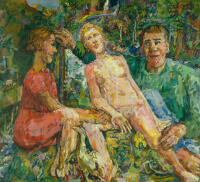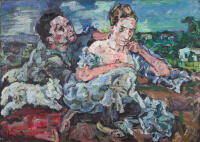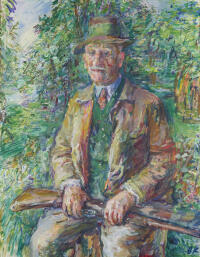Oskar Kokoschka – Expressionist, Migrant, Europäer. Eine Retrospektive
14.12.2018 – 10.03.2019
Curated by Cathérine Hug.
Location Pfister-Bau (Grosser Ausstellungssaal, ehem. Bührlesaal).
Curated by Cathérine Hug.
Location Pfister-Bau (Grosser Ausstellungssaal, ehem. Bührlesaal).
The Kunsthaus Zürich is presenting Oskar Kokoschka, the expressionist, migrant and European, in a comprehensive retrospective in Zurich for the first time since 1986. A long friendship connects the institution with this artist and dedicated its first solo presentation to him as early as 1927.
Highlights among the approximately 368 catalogue entries are the juxtaposition of the two monumental triptychs, ‘Die Prometheus Saga’ (The Courtauld Gallery, London) and ‘Thermopylae’ (University of Hamburg), and the ‘Mural for Alma Mahler’ (private collection), which have never been seen in Switzerland before. All his creative phases and his media, especially his sketchbooks (Fondation Kokoschka, Vevey) were first comprehensively examined in a retrospective. Kokoschka, together with Francis Picabia and Pablo Picasso belongs to a generation of painters who remained faithful to figurative painting after World War II, at a time when abstraction was establishing its dominance. It is partly due to them that today abstract and figurative painting can be practiced alongside each other without ideological trench warfare. Artists of today appeal especially to Kokoschka. Explicitly or implicitly, his Expressionist painting style is a source of inspiration for Nancy Spero, Martha Jungwith, Georg Baselitz, Herbert Brandl and Denis Savary. They value the gestural articulation of his brushwork, praise the cosmopolitan character of this Viennese artist, or share the pacifist attitude which is a central feature of Kokoschka’s work, life, and legacy.
In association with all this, a publication of 320 pages has appeared. It was possible to win over the most important Kokoschka experts for new contributions: Régine Bonnefoit, Iris Bruderer-Oswald, Martina Ciardelli, Birgit Dalbajewa, Heike Eipeldauer, Katharina Erling, Cathérine Hug, Aglaja Kempf, Alexandra Matzner, Raimund Meyer, Bernadette Reinhold, Heinz Spielmann and Patrick Werkner.
A wide-ranging program of discussions was set up with about eight events on such various topics as Kokoschka’s doll with Talaya Schmid and Angela Walti, Kokoschka as ‘decadent’ artist with Bernadette Reinhold (Kokoschka Research Center Vienna) in cooperation with the SIK-ISEA, the meeting between Dürrenmatt and Kokoschka at the ‘Salon Dürrenmatt’ with Madeleine Betschart, Régine Bonnefoit and Peter Nobel in cooperation with the Centre Dürrenmatt Neuchâtel, Rüdiger Görner’s new Kokoschka biography, Karl Kraus‘ significance for Kokoschka with Slam Poet Jurczok 1001, and Kokoschka’s art dealers with Walter Feilchenfeldt (co-author of the online Kokoschka catalogue raisonné) and Juri Steiner (art historian and curator), most of them allocated to 2019.
The crowds of visitors and the media response already exceeded our expectations on the first day of opening. On January 3, 2019, in a full-page article in the Wall Street Journal, Adam Goldmann described his impression of the exhibition tour as follows: ‘The effect of having journeyed so far through time is staggering. Nearly four decades after Kokoschka’s death, the Kunsthaus Zurich has given us new hope that his singular artistic universe will endure.’
Sponsored by UNIQA Österreich Versicherungen AG, Kunstversicherung Schweiz, who was also the main sponsor enabling the restoration of the triptych ‘The Prometheus Saga’ (The Courtauld Gallery, London); the Federal Office for Culture, the Hulda and Gustav Zumsteg Foundation, the Boston Consulting Group, the Truus and Gerrit van Riemsdijk Foundation and the Dr. Georg and Josi Guggenheim Foundation.
[Cathérine Hug]
'This art of painting should show representational content and space, in keeping with a European in contact with their history. I show an idea of space to which I consciously added the fourth dimension of movement discovered in the Baroque period. It enables the viewer to read the painting, as it were, in time, in the sequence of described events from beginning to end.'Oskar Kokoschka, 1952
86 days
2 Artists
2 Artists
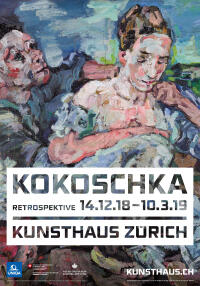
1/6
exhibition poster

2/6
exhibition view
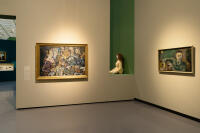
3/6
exhibition view
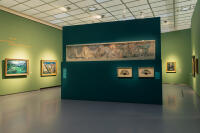
4/6
exhibition view

5/6
exhibition view
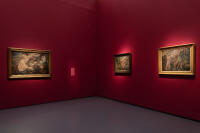
6/6
exhibition view
1/6
